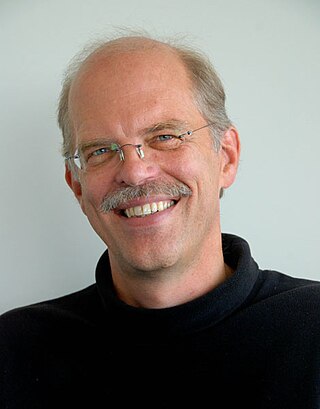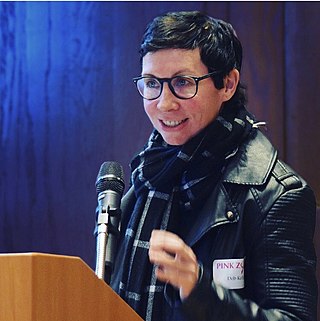Related Research Articles

Endocytosis is a cellular process in which substances are brought into the cell. The material to be internalized is surrounded by an area of cell membrane, which then buds off inside the cell to form a vesicle containing the ingested materials. Endocytosis includes pinocytosis and phagocytosis. It is a form of active transport.

Structural biology, as defined by the Journal of Structural Biology, deals with structural analysis of living material at every level of organization.
An epitope, also known as antigenic determinant, is the part of an antigen that is recognized by the immune system, specifically by antibodies, B cells, or T cells. The part of an antibody that binds to the epitope is called a paratope. Although epitopes are usually non-self proteins, sequences derived from the host that can be recognized are also epitopes.

MHC class I molecules are one of two primary classes of major histocompatibility complex (MHC) molecules and are found on the cell surface of all nucleated cells in the bodies of vertebrates. They also occur on platelets, but not on red blood cells. Their function is to display peptide fragments of proteins from within the cell to cytotoxic T cells; this will trigger an immediate response from the immune system against a particular non-self antigen displayed with the help of an MHC class I protein. Because MHC class I molecules present peptides derived from cytosolic proteins, the pathway of MHC class I presentation is often called cytosolic or endogenous pathway.

PIPES is a frequently used buffering agent in biochemistry. It is an ethanesulfonic acid buffer developed by Good et al. in the 1960s.

Stimulated emission depletion (STED) microscopy is one of the techniques that make up super-resolution microscopy. It creates super-resolution images by the selective deactivation of fluorophores, minimizing the area of illumination at the focal point, and thus enhancing the achievable resolution for a given system. It was developed by Stefan W. Hell and Jan Wichmann in 1994, and was first experimentally demonstrated by Hell and Thomas Klar in 1999. Hell was awarded the Nobel Prize in Chemistry in 2014 for its development. In 1986, V.A. Okhonin had patented the STED idea. This patent was unknown to Hell and Wichmann in 1994.

MHC Class II molecules are a class of major histocompatibility complex (MHC) molecules normally found only on professional antigen-presenting cells such as dendritic cells, macrophages, some endothelial cells, thymic epithelial cells, and B cells. These cells are important in initiating immune responses.

Eva Nogales is a Spanish-American biophysicist at the Lawrence Berkeley National Laboratory and a professor at the University of California, Berkeley, where she served as head of the Division of Biochemistry, Biophysics and Structural Biology of the Department of Molecular and Cell Biology (2015–2020). She is a Howard Hughes Medical Institute investigator.

CD63 antigen is a protein that, in humans, is encoded by the CD63 gene. CD63 is mainly associated with membranes of intracellular vesicles, although cell surface expression may be induced.

Transporter associated with antigen processing 1 (TAP1) is a protein that in humans is encoded by the TAP1 gene. A member of the ATP-binding cassette transporter family, it is also known as ABCB2.

CD82, or KAI1, is a human protein encoded by the CD82 gene.

Tripeptidyl-peptidase 2 is an enzyme that in humans is encoded by the TPP2 gene. Among other things it is heavily implicated in MHC (HLA) class-I processing, as it has both endopeptidase and exopeptidase activity.
Super-resolution microscopy is a series of techniques in optical microscopy that allow such images to have resolutions higher than those imposed by the diffraction limit, which is due to the diffraction of light. Super-resolution imaging techniques rely on the near-field or on the far-field. Among techniques that rely on the latter are those that improve the resolution only modestly beyond the diffraction-limit, such as confocal microscopy with closed pinhole or aided by computational methods such as deconvolution or detector-based pixel reassignment, the 4Pi microscope, and structured-illumination microscopy technologies such as SIM and SMI.

Immunogold labeling or immunogold staining (IGS) is a staining technique used in electron microscopy. This staining technique is an equivalent of the indirect immunofluorescence technique for visible light. Colloidal gold particles are most often attached to secondary antibodies which are in turn attached to primary antibodies designed to bind a specific antigen or other cell component. Gold is used for its high electron density which increases electron scatter to give high contrast 'dark spots'.
Immunoevasins are proteins expressed by some viruses that enable the virus to evade immune recognition by interfering with MHC I complexes in the infected cell, therefore blocking the recognition of viral protein fragments by CD8+ cytotoxic T lymphocytes. Less frequently, MHC II antigen presentation and induced-self molecules may also be targeted. Some viral immunoevasins block peptide entry into the endoplasmic reticulum (ER) by targeting the TAP transporters. Immunoevasins are particularly abundant in viruses that are capable of establishing long-term infections of the host, such as herpesviruses.

Jean Pieters is a Dutch biochemist and Professor at the Biozentrum of the University of Basel, Switzerland.

Hidde Lolke Ploegh is an immunologist at Boston Children's Hospital, known for his contributions in understanding antigen processing and the evasion of the immune system by viruses.

Jacques (Sjaak) Neefjes is a Dutch scientist who made breakthroughs in several research disciplines such as immunology, cell biology, chemistry, cancer biology, microbiology, and epidemiology. He is a professor at the Leiden University Medical Center. In 2020 he was one of four winners of the Spinoza Prize.

Ron M.A. Heeren is a Dutch scientist in mass spectrometry imaging. He is currently a distinguished professor at Maastricht University and the scientific director of the Multimodal Molecular Imaging Institute (M4I), where he heads the division of Imaging Mass Spectrometry.

Deborah F. Kelly is an American biomedical engineer who is a professor at Pennsylvania State University. Her research makes use of cryogenic electron microscopy to better understand human development and disease. She serves as President of the Microscopy Society of America.
References
- 1 2 "Distinguished university professors". Maastricht University. Retrieved 7 November 2021.
- 1 2 "Top nanobiologist Peter Peters to Maastricht University". Instruct Integrating Biology. Retrieved 16 August 2018.
- ↑ "Prof. Peter J. Peters from Maastricht University of the Netherlands made a BEI Shinzhang Lecutre". Chinese Academy of Sciences. July 2016. Retrieved 16 August 2018.
- 1 2 3 4 "Peter Peters Group". Netherlands Cancer Institute. Retrieved 16 August 2018.
- ↑ Peters, Peter J.; Neefjes, Jacques J.; Oorschot, Viola; Ploegh, Hidde L.; Geuze, Hans J. (1991). "Segregation of MHC class II molecules from MHC class I molecules in the Golgi complex for transport to lysosomal compartments". Nature. 349 (6311): 669–676. doi:10.1038/349669a0. ISSN 1476-4687. PMID 1847504. S2CID 4242062.
- ↑ Peters, P. J.; Raposo, G.; Neefjes, J. J.; Oorschot, V.; Leijendekker, R. L.; Geuze, H. J.; Ploegh, H. L. (1995-08-01). "Major histocompatibility complex class II compartments in human B lymphoblastoid cells are distinct from early endosomes". Journal of Experimental Medicine. 182 (2): 325–334. doi:10.1084/jem.182.2.325. ISSN 0022-1007. PMC 2192145 . PMID 7629497.
- ↑ Peters, P. J.; Borst, J.; Oorschot, V.; Fukuda, M.; Krähenbühl, O.; Tschopp, J.; Slot, J. W.; Geuze, H. J. (1991-05-01). "Cytotoxic T lymphocyte granules are secretory lysosomes, containing both perforin and granzymes". Journal of Experimental Medicine. 173 (5): 1099–1109. doi:10.1084/jem.173.5.1099. ISSN 0022-1007. PMC 2118839 . PMID 2022921.
- ↑ Peters, P. J.; Hsu, V. W.; Ooi, C. E.; Finazzi, D.; Teal, S. B.; Oorschot, V.; Donaldson, J. G.; Klausner, R. D. (1995-03-15). "Overexpression of wild-type and mutant ARF1 and ARF6: distinct perturbations of nonoverlapping membrane compartments". J Cell Biol. 128 (6): 1003–1017. doi:10.1083/jcb.128.6.1003. ISSN 0021-9525. PMC 2120412 . PMID 7896867.
- ↑ van der Wel, Nicole; Hava, David; Houben, Diane; Fluitsma, Donna; Zon, Maaike van; Pierson, Jason; Brenner, Michael; Peters, Peter J. (2007). "M. tuberculosis and M. leprae Translocate from the Phagolysosome to the Cytosol in Myeloid Cells". Cell. 129 (7): 1287–1298. doi: 10.1016/j.cell.2007.05.059 . PMID 17604718.
- ↑ "Bestuur en leden – AcTI".
- ↑ "19th International Microscopy Congress (IMC19)".
- ↑ Aschwanden, Christie (2006). "Professionalizing the Postdoctoral Experience". Cell. 124 (3): 445–447. doi: 10.1016/j.cell.2006.01.025 . PMID 16469686.
- ↑ Aschwanden, Christie (2006). "Learning to Lead". Cell. 125 (3): 407–409. doi: 10.1016/j.cell.2006.04.017 . PMID 16678082.
- ↑ "Best Places to Work 2008: Postdocs". The Scientist. Retrieved 2018-01-23.
- ↑ Griekspoor, Alexander (2007-02-21). "Torn between two ladders". Nature. 445 (7130): 948. doi: 10.1038/nj7130-948b .
- ↑ "Robert Feulgen Lectures". Society for Histochemistry. Retrieved 16 August 2018.
- ↑ "PJ Peters citations".